The extensive Copper Age site of Valencina de la Concepción was in use from 3000 BC to 1500 BC during which time a number of dolmens and passage graves were built.
By Nick Nutter | Updated 4 Jun 2023 | Seville | Places To Go |
Login to add to YOUR Favourites or Read Later
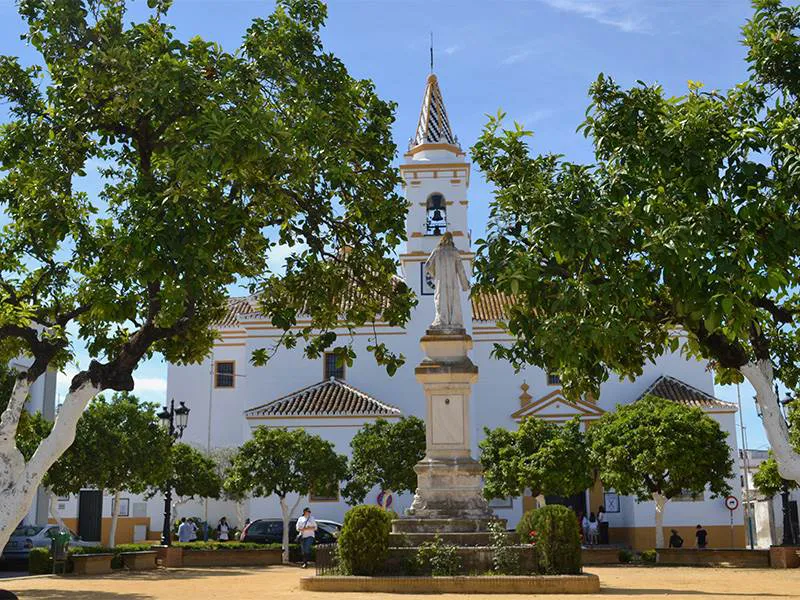
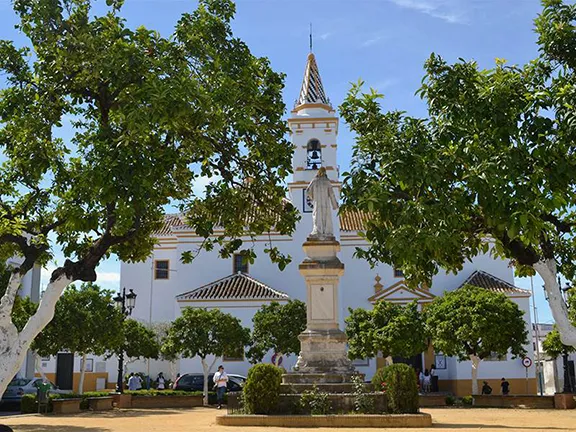
Valencina de la Concepción today
A few kilometres west of Seville is the small town of Valencina de la Concepción. The modern town is situated on the edge of a ridge overlooking Seville and the wide fertile valley of the Guadalquivir. 5000 years ago, the same site overlooked a large bay that connected with the Atlantic Ocean. It was in a favoured position, with food resources, fish and wildfowl available from the saltwater estuary, the fresh waters of the Guadalquivir that entered the bay a few kilometres northeast of the site, and the fertile land around the village.
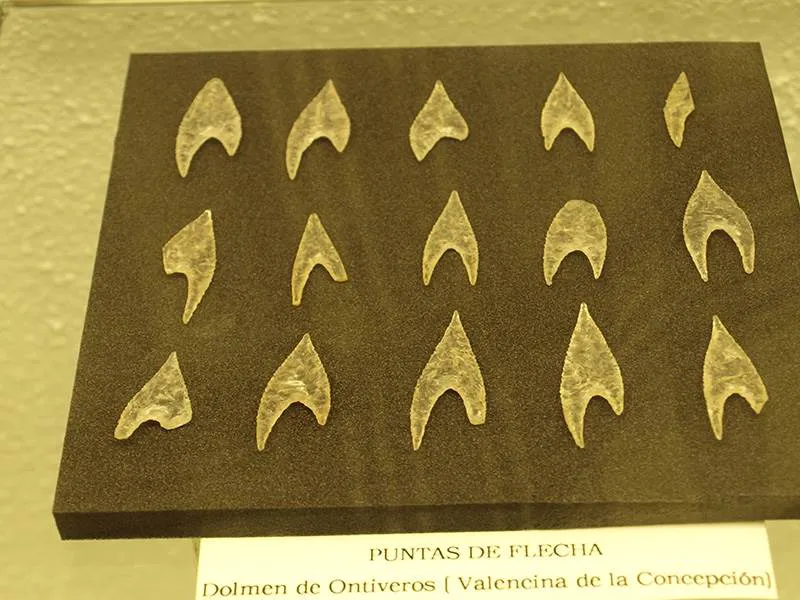
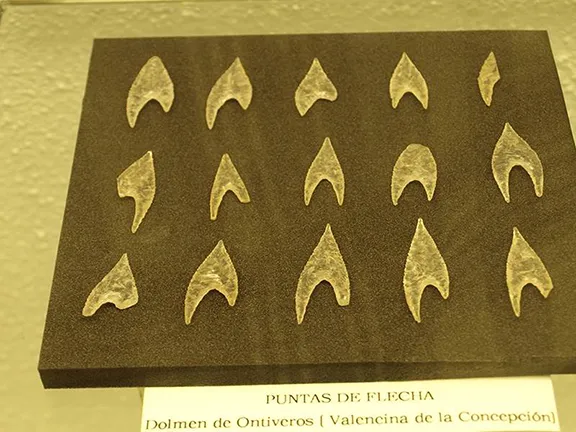
Arrow heads
Between the areas cleared for agriculture, the vegetation consisted of native broadleaf trees and Mediterranean scrub similar to that found today in the nearby Natural Parks. Those wooded and maquis covered areas were the home of rabbits, foxes, badgers, roe deer and other mammals. A combination of Mesolithic style hunter-gathering and Neolithic style agriculture and animal husbandry ensured the population had a varied and healthy diet. To date, the site is similar to those sites found on the Tagus estuary in as much as the Neolithic had not yet totally replaced the Mesolithic and resources were sufficient to support a population large enough to have evolved either, a social system that involved an elite leadership, or a large egalitarian society capable of displaying an unusual degree of mutual cooperation. In other respects Valencina de la Concepción stands alone as we shall see even when compared to other contemporary sites in the south-west Iberian Peninsula area.
The site was occupied from about 3000 BC to 1500 BC by a group of people who lived in round mud-walled huts roofed with thatch. They kept domesticated pigs and goats and cultivated the surrounding land. They also hunted in the hinterland and fished in the estuary and river. Overall, the site covers an area of between 300 and 400 hectares but whether the entire site was occupied or used at the same time is not yet known due to a lack of reliable chronology.
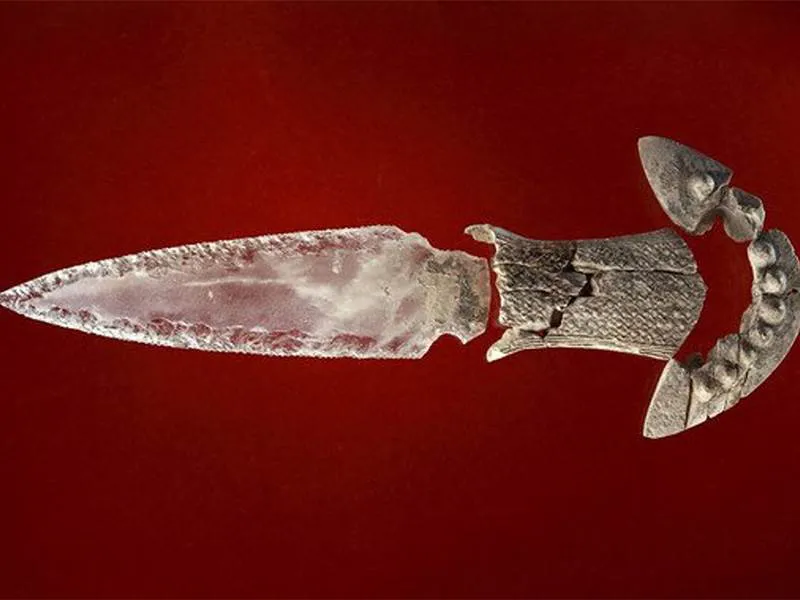
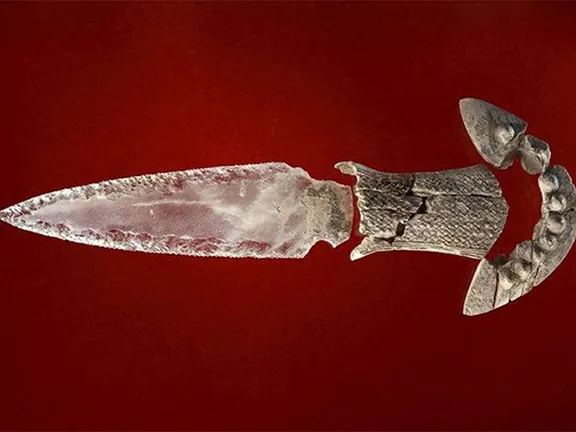
Crystal Dagger
The site also includes a remarkable number, over a dozen, megalithic dolmens, many of which contained multiple burials. 135 burials have been found, 86 of which were in dolmens. Looking at all the burials at Valencina de la Concepción, there appears to be no one burial that stands out as being that of a person more favoured than others whether laid to rest in a dolmen or in a ditch. Only 10 small gold ornaments have been found associated with burials with a total weight of 5 grams and, excluding the 29 javelin points found outside the dolmen of La Pastoral, no metal artefacts identified solely as weapons have been found at all. Metal artefacts classified as weapons/tools include axes of which 20 have been found associated with burials. This situation may change as a result of excavation of the tholos dolmen called Montelirio (see updated report on the excavations of Montelirio towards the end of this article).
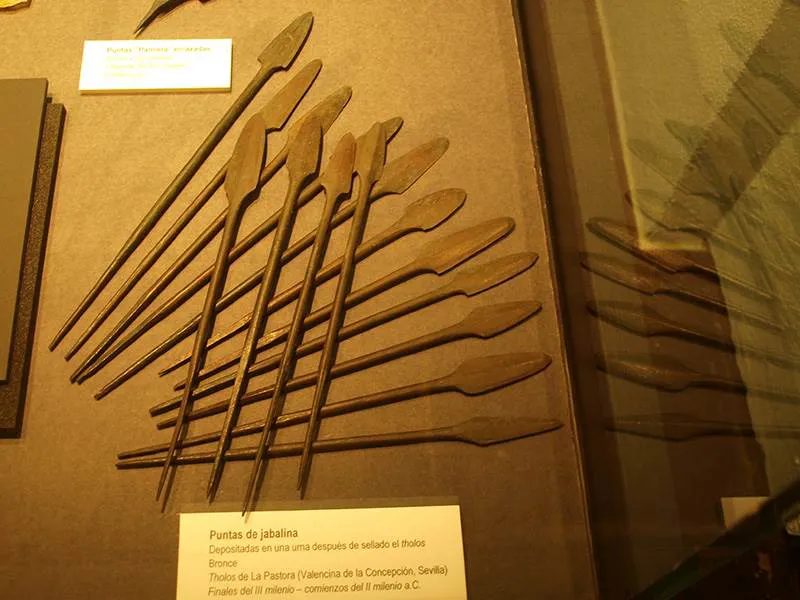
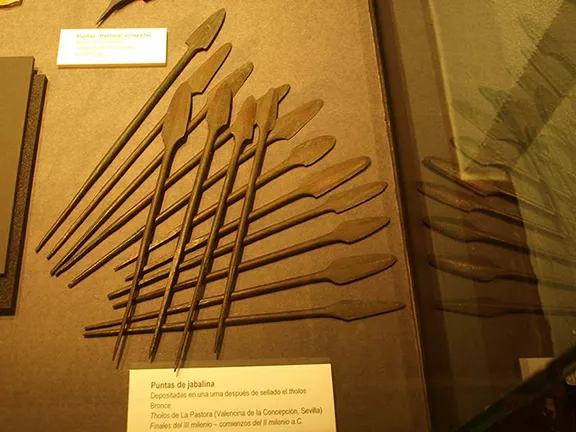
Javelin Heads
The evidence so far all suggests a system of social organization basically akin to the notion of communal ranking proposed in relation to the Copper Age societies of the southwestern Iberian Peninsula. This notion is based on that of corporate or group-oriented society, which has also been used in relation with Marroquíes Bajos, a large Copper Age settlement situated further up the Guadalquivir valley. Coercion does not seem to play a major role in the mobilisation of labour of southern Iberian Copper Age societies or indeed in their structure of social relations of production as a whole.
The occupants of Valencina, spared coercion from within their own society, obviously felt no threat from without either. Unlike many contemporary sites, Valencina de la Concepción did not have a defensive wall and there is no sign of violence when the site was, apparently, abandoned. There is some evidence of a deep ditch but at the moment excavations have not shown whether it was dug for defence, as a rubbish dump or as a preliminary stage in some other project, for instance a grain store. As a matter of interest, remains of a total of 18 individuals have been found in the infill of the ditch in three separate locations.
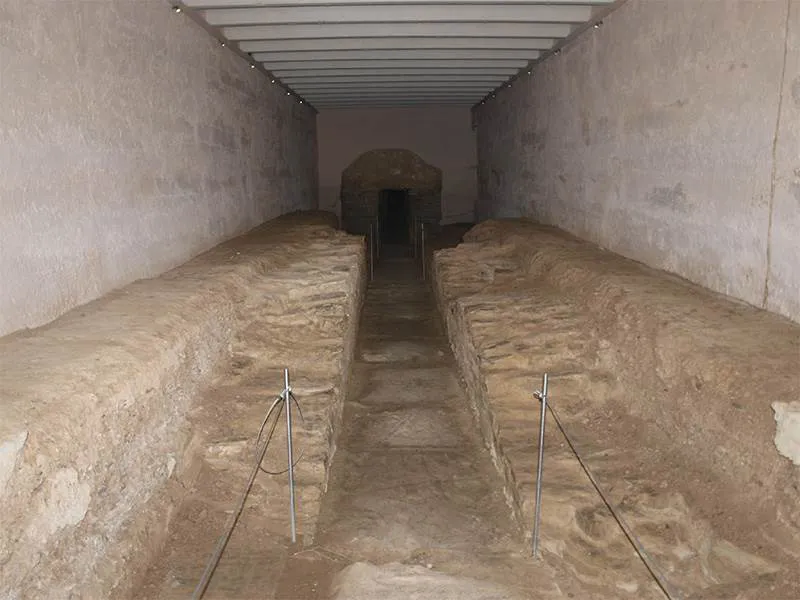
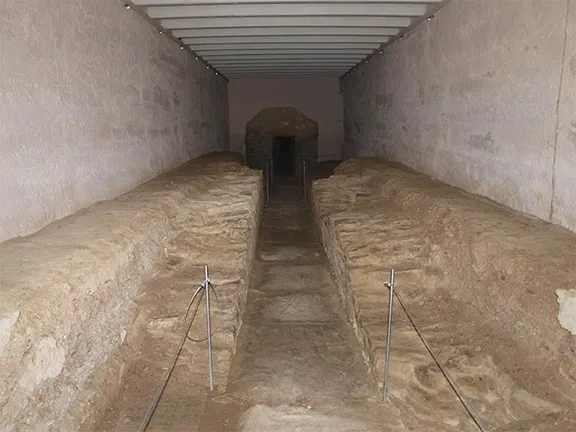
Entrance to La Pastora
Signs of metalworking are found throughout the domestic area, crucibles, furnaces, slag and minerals. In fact, Valencina has yielded the greatest collection of metal artefacts from the period 3100 to 2200 BC (regarded as the Iberian Copper Age) of any site in Iberia to date (2018).
Of the finished metallic product, Valencina de la Concepción has yielded one notable find, 29 javelin points found in the vicinity of the La Pastora tholos. They have been dated to the centuries between the 2nd and 3rd millennium BC, that is either side of 2000 BC. Studies have shown that the javelin points were manufactured locally, though not necessarily at Valencina de la Concepción and from minerals obtained from more than one source in the Iberian south west.
Two dolmens can be visited, La Pastora and Matarrubilla. You will be accompanied by a guide and the visit has to be pre-booked. To do this call at the Centro Municipal Civico Cultural, Plaza de Espana, Valencina. (+34 955 72 02 11 Open Tuesday - Sunday, 10am to 2pm) There you will find a Centro de Interpretacion with some of the finds made at the archaeological site. The attendants will also encourage you to watch an informative video about the site. They will contact a guide and arrange for him to meet you at the entrance to the La Pastora dolmen. After seeing this dolmen you will follow the guide who will drive to the Matarrubilla site.
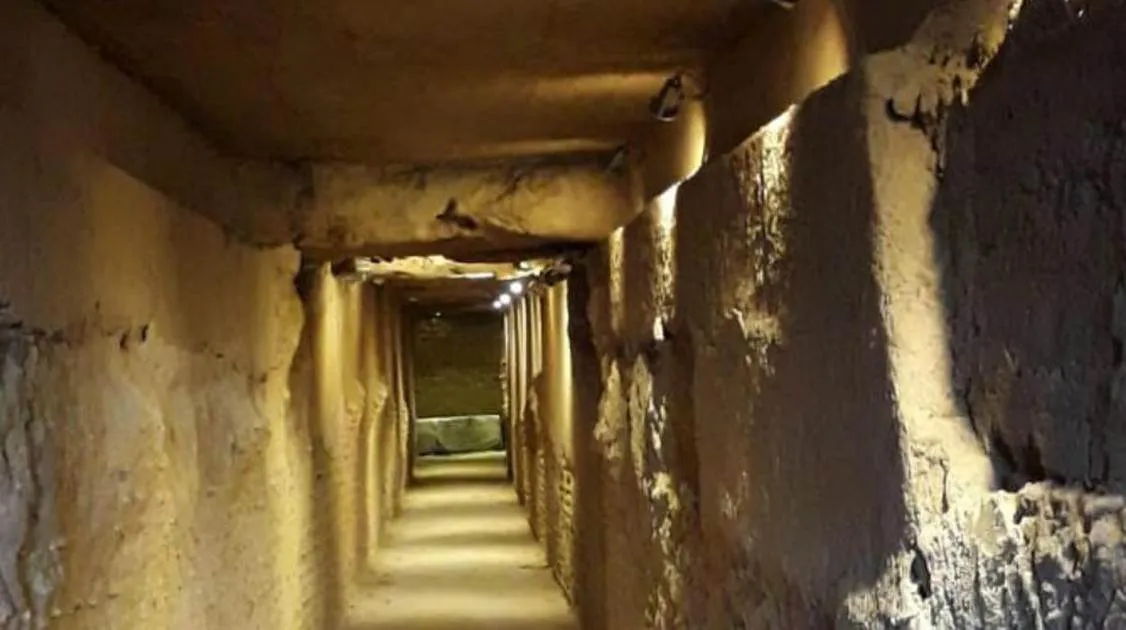
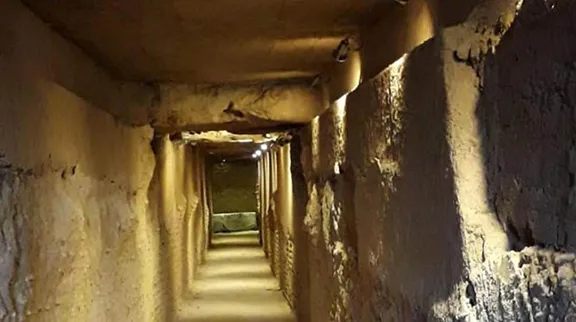
Entrance to Matarrubilla
La Pastora is a 43.1 metre long passage grave, made with drystone walls and roofed with slabs of limestone and granite. The passage is divided into three by the use of orthostats that protrude into the passageway creating open 'doorways'. It is considered to be the longest passage grave in the Iberian peninsula. Unlike most other passage graves in the peninsula, that of La Pastora faces the west, sunset.
The passage terminates in a circular funeral chamber with a diameter of 2.5 metres, roofed with a single granite capstone. Of the tholos type, the dome is constructed from mud brick
Matarrubilla is also a passage grave. The passage is 32 metres in length and constructed from stone and layers of clay covered in large limestone slabs. The floor is packed loam. The chamber has masonry cladding and clay bricks forming a false dome topped with a granite slab. Within the chamber, and taking up most of the space, is a carved marble block that features a recess in its upper surface. It has been proposed that this was an altar or offering table.
Structure 10042/10049 is a two-chambered megalithic construction. This construction has an outer access corridor 13 m in length and 0.7m in width (maximum), made from 57 slate slabs (29 on its northern side, 28 on the southern); at the end of this corridor is the first chamber, with a circular plan of 2.57 m in diameter, which was found disturbed by later activity. In the space between the access corridor and the first chamber, skeletal remains of four individuals were identified as well as some grave goods, including more than 2000 beads covered in red pigment, fragments of a fired clay figurine, more than 800 sherds of pottery (some of them intrusive wheel-thrown ones), fragments of 12 arrowheads, 3 blade fragments, some lithic chipping debris and some very fragmented ivory objects.
Beyond the first chamber, a second corridor of 2.52 m (length) by 0.51 m (width) and formed from 15 slate slabs (7 on the north side and 8 on the south) separates the first and the second burial chambers. This second chamber, found in a much better state of preservation than the first, has a maximum diameter of 2.1m and is formed from 23 slabs of slate. The excavation inside the second chamber led to the identification of two stratigraphically independent deposits separated by a set of 22 slate slabs laid horizontally which may be interpreted as some sort of ‘seal’ between the lower and upper depositional levels.
The lower depositional level of the second chamber contained the articulated inhumation of a young male individual aged between 17 and 25 lying in the foetal position, in connection with a large set of grave goods, including an undecorated elephant tusk, one ‘almond-rim’ type plate, a set of 23 flint blades, one flint halberd with an amber pommel as well as numerous ivory objects. Red pigment made from cinnabar had been sprayed all over this individual and the objects surrounding him. In the upper depositional level of the second chamber, the finds comprised five ceramic pots (two complete plates, one with red pigment, and two half plates, one of them also with red stains), 38 whole flint blades and 16 fragments of other blades, one flint arrowhead, numerous ivory objects (most of them decorated and quite fragmented, between them a palette and the terminal extreme of a tusk, both decorated), 90 beads, and an ostrich egg (which has now disappeared) as well as a remarkable rock crystal dagger blade.
The Montelirio tholos was excavated between 2007 and 2010, and with the exception of a preliminary report (Fernandez Flores and Aycar Luengo, 2013) and some results of the anthropological study (Fontanals-Coll et al., 2015) remains basically unpublished. It is a great megalithic construction with a 39 m corridor leading to a main chamber which is 4.75 m in diameter from which, through a short 1.9 m-long corridor, a secondary chamber, 2.7 m in diameter, is accessible. The whole construction, which extends over 43.75 m in total, is made of large slabs of slate, which were also used for the corridors' sides as well as the chambers and the main corridor's roofing. The corbelled roofing of the two chambers was built with sun-dried mud. A total minimum number of 25 individuals has been identified within the construction (20 in the large chamber, two in the small one and three in the corridor). At the time of writing Montelirio is not open to the public.
Inside Montelirio, an extraordinary set of sumptuous grave goods was found, the most notable of which is an unspecified number of shrouds or clothes made of tens of thousands of perforated beads and decorated with amber beads, but including also other remarkable objects such as flint arrowheads with long lateral appendices, four fragments of gold blades and ivory objects.
It will be interesting to see the dating, when published, for the bodies and grave goods from Montelirio. Tholoi tend to be of much later design than passage chamber tombs constructed using orthostats and capstones. It may be that the society at Valencina de la Concepción evolved from an egalitarian into an authoritarian society, which would not be surprising given the size of the community.
For opening times of the Dolmens of Valencina de la Concepción, click here